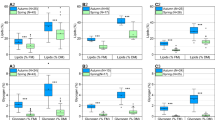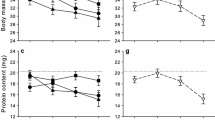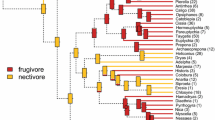Abstract
Restoration of fat stores is metabolic first priority for many insects that emerge from hibernation with depleted fat bodies. To some extent, the animals must be flexible and use whatever foods available irrespective of their nutrient composition. Previously, the carabid beetles Anchomenus dorsalis have been found to refill their fat stores to the same extent over 9 days irrespective of the nutrient composition of their food. However, a higher cost of fat deposition when the food was rich in sugar or protein rather than lipid was indicated by higher total energy consumption. Here, we test the hypothesis of increased metabolic costs of building fat stores from sugar- or protein-rich food than from lipid-rich food by microcalorimetry. We measured the heat emitted from beetles that had fed on sugar-, protein-, or lipid-rich food for 0 (common control), 2, 5, or 10 days. As predicted, heat emission was increased in beetles getting sugar- and protein-rich food compared with those getting lipid-rich food. However, we did not confirm the beetles’ ability to rebuild fat stores from protein-rich food; instead, they increased in lean mass. Overall, sugar-rich food seems to be optimal for post-winter recovery, because it is better than lipid-rich food that allows concurrent rebuilding of fat stores and lean mass, which may benefit preparation for spring migration and reproduction. We propose that overwintered fruits may be highly preferred post-diapause food for these otherwise mostly carnivorous beetles.


Similar content being viewed by others
References
Adedokun TA, Denlinger DL (1985) Metabolic reserves associated with pupal diapause in the flesh fly, Sarcophaga crassipalpis. J Insect Physiol 31:229–233
Arrese EL, Soulages JL (2010) Insect fat body: energy, metabolism, and regulation. Annu Rev Entomol 55:207–225
Baranovska E, Knapp M, Saska P (2014) The effects of overwintering, sex, year, field identity and vegetation at the boundary of fields on the body condition of Anchomenus dorsalis (Coleptera: Carabidae). Eur J Entomol 111:608–614
Bradley MC, Perrin N, Calow P (1991) Energy allocation in the cladoceran Daphnia magna Straus, under starvation and refeeding. Oecologia 86:414–418
Canavoso LE, Jouni ZE, Karnas KJ, Pennington JE, Wells MA (2001) Fat metabolism in insects. Annu Rev Nutr 21:23–46
Coombes DS, Sotherton NW (1986) The dispersal and distribution of polyphagous predatory Coleoptera in cereals. Ann Appl Biol 108:461–474
Denlinger DL, Yocum GD, Rinehart JL (2005) Hormonal control of diapause. In: Gilbert LI, Iatrou K, Gill SS (eds) Comprehensive molecular insect science, vol 3. Elsevier Press, Amsterdam, pp 615–650
Downer RGH (1978) Functional role of lipids in insects. In: Rockstein M (ed) Biochemistry of insects. Academic Press, New York, pp 57–92
Eckert R (1983) Animal physiology. Mechanisms and adaptations, 2nd edn. WH Freeman & Co., San Francisco.
Hahn DA, Denlinger DL (2007) Meeting the energetic demands of insect diapause: nutrient storage and utilization. J Insect Physiol 53:760–773
Hahn DA, Denlinger DL (2011) Energetics of insect diapause. Annu Rev Entomol 56:103–121
Jensen K, Mayntz D, Toft S, Clissold F, Raubenheimer D, Simpson SJ (2012) Optimal foraging for specific nutrients in predatory beetles. Proc Royal Soc B 279:2212–2218
Jensen TS, Dyring L, Kristensen B, Nielsen BO, Rasmussen ER (1989) Spring dispersal and summer habitat distribution of Agonum dorsale (Coleoptera, Carabidae). Pedobiologia 33:155–165
Keeley LL (1985) Physiology and biochemistry of the fat body. In: Kerkut GA, Gilbert LI (eds) Comprehensive insect physiology, biochemistry, and pharmacology, Integument, vol III. Respiration and Circulation. Pergamon Press, Oxford, pp 211–248
Knapp M, Uhnavá K (2014) Body size and nutrition intake effects on fecundity and overwintering success in Anchomenus dorsalis (Coleoptera: Carabidae). J Insect Sci 14(240)
Kostal V (2006) Eco-physiological phases of insect diapause. J Insect Physiol 52:113–127
Lamprecht I (1998) Monitoring metabolic activities of small animals by means of microcalorimetry. Pure Appl Chem 70:695–700
Leather SR, Walters KFA, Bale JS (1993) The ecology of insect overwintering. Cambridge University Press, Cambridge
Lyndon AR, Houlihan DF, Hall SJ (1992) The effect of short-term fasting and a single meal on protein synthesis and oxygen consumption in cods, Gadus morhua. J Comp Physiol B 162:209–215
McCauley E, Murdoch WW, Nisbet RM, Gurney WSC (1990) The physiological ecology of Daphnia: development of a model of growth and reproduction. Ecology 71:703–715
Nielsen SA, Jensen KMV, Kristensen M, Westh P (2006) Energetic cost of subacute chlorpyrifos intoxication in the German cockroach (Dictyoptera: Blatellidae). Envir Entomol 35:837–842
Noreika N, Madsen NEL, Jensen K, Toft S (2016) Balancing of lipid, protein, and carbohydrate intake in a predatory beetle following hibernation, and consequences for lipid restoration. J Insect Physiol 88:1–9
Perrin N, Bradley MC, Calow P (1990) Plasticity of storage allocation in Daphnia magna. Oikos 59:70–74
Pollard E, Hooper MD, Moore NW (1974) Hedges. Collins, London
Raubenheimer D, Mayntz D, Simpson SJ, Toft S (2007) Nutrient-specific compensation following diapause in a predator: implications for intraguild predation. Ecology 88:2598–2608
Reeds PJ, Wahle KWJ, Haggarty P (1982) Energy costs of protein and fatty acid synthesis. Proc Nutr Soc 41:155–159
Secor SM (2009) Specific dynamic action: a review of the postprandial metabolic response. J Comp Physiol B 179:1–56
Tan QQ, Feng L, Liu W, Zhu L, Lei CL, Wang XP (2016) Differences in the pre-diapause and pre-oviposition accumulation of critical nutrients in adult females of the beetle Colaphellus bowringi. Entomol Exp Appl 160:115–125
Thomas CFG, Holland JM, Brown NJ (2002) Spatial distribution of carabid beetles in agricultural landscapes. In: Holland JM (ed) The agroecology of carabid beetles. Intercept, Andover, pp 305–344
Toft S, Bilde T (2002) Carabid diets and food value. In: Holland JM (ed) The agroecology of carabid beetles intercept, Andover, pp 81–110
Wadsö L, Hansen LD (2015) Calorespirometry of terrestrial organisms and ecosystems. Methods 76:11–19
Acknowledgements
We are indebted to Henning Bjerregaard for valuable discussions on the biochemical interpretation of our results and to two anonymous reviewers for valuable comments.
Author information
Authors and Affiliations
Corresponding author
Ethics declarations
Funding
ST was supported by a grant from the Carlsberg Foundation.
Conflict of interest
The authors declare that they have no conflict of interest.
Additional information
Communicated by: Sven Thatje
Electronic supplementary material
Fig. S1
(DOCX 17 kb)
Rights and permissions
About this article
Cite this article
Toft, S., Nielsen, S.A. Diet-dependent heat emission reveals costs of post-diapause recovery from different nutritional sources in a carnivorous beetle. Sci Nat 104, 58 (2017). https://doi.org/10.1007/s00114-017-1481-5
Received:
Revised:
Accepted:
Published:
DOI: https://doi.org/10.1007/s00114-017-1481-5




